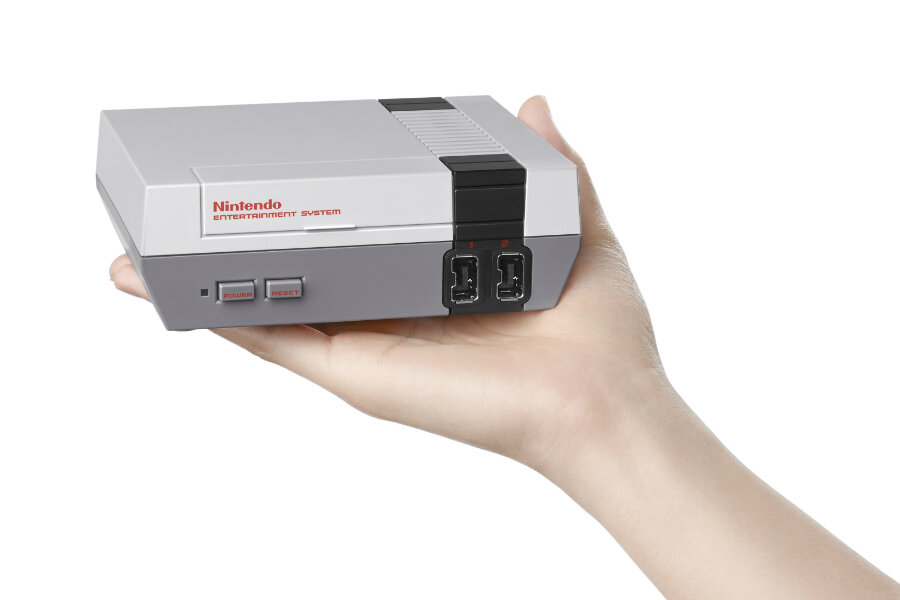Why classic video games are getting a second wind
Loading...
This week, revamped versions of two classic video game consoles – the Nintendo Entertainment System and the Sega Genesis – went back on the market.
These consoles may boast some upgraded tech, but both feature the same 8-bit and 16-bit games that made them famous. The NES Classic Edition is a USB-powered, HDMI-compatible reproduction that comes with 30 titles built-in. It even looks just like the original console, albeit much smaller. The Sega Genesis Classic, which plays actual cartridges and includes wireless controllers, was re-released to celebrate the 25th anniversary of the first Sonic the Hedgehog game.
In the past decade, there has been a market resurgence for long-dead technologies. Suddenly, consumers are buying up record players, cassette tapes, and old video game consoles like it's 1985. But are we living in a new age of nostalgia, induced by the changing world around us? Or have we always been living – at least a little bit – in the past?
Nostalgia is a very old concept, deeply ingrained in the human psyche. All it takes is a familiar smell, or a melody from a long-forgotten childhood song, to send us spiraling down memory lane. But why do we experience it?
Recent studies have tied nostalgia to certain psychological threats. When we feel lonely, uncertain, or without purpose, a sense of nostalgia can restore feelings of belonging and meaning. It can even motivate people to pursue new opportunities to feel connected.
“In this way, nostalgia is a mental stabilizer,” Clay Routledge, a professor of psychology at North Dakota State University, tells The Christian Science Monitor in an email. “When people feel alone or like they do not matter, they can bring to mind experiences from the past that made them feel happy and loved. This activity gives them confidence and a renewed energy and feeling of youthfulness.”
For over a decade, Dr. Routledge has studied the causes and effects of nostalgia. But while previous trends appeared to focus on particular eras – in the 1970s, for example, there was a massive revival of 1950s-style music – “new nostalgia” seems to be a bit less clear-cut.
Peek into any trendy urban department store, and you’ll find re-pressed vinyl records of albums that came out in the 1960s and 1970s, displayed prominently at the entrance. Walk a little further, and you’ll find fashion meant to evoke the 1990s: flannels, jelly sandals, and torn light-wash jeans.
All Nintendo had to do to re-capitalize on its classic console, which originally launched in 1985, was add a USB port and an HDMI output. Unlike previous decades, the 2010s are a grab bag of nostalgia. So what changed?
“One possibility is that the modern nostalgia marketplace makes it easier to access a range of nostalgia sources,” Routledge says. “Just like people have more entertainment and news choices, allowing them to customize the media they consume, it is possible that technology has allowed people more ways to explore nostalgia.”
It could also be that drastic social and cultural changes, many of which have taken place in the past decade, may make nostalgia particularly attractive. As the country battles over issues of race, gender identity, police violence, and immigration, some may yearn for a simpler time.
“It is true that life and social uncertainties, what we refer to as discontinuity, drive nostalgia,” Routledge says. “When people feel uncertain or lost, they turn to the past to find their center, to restore a sense of continuity and identity.”
But nostalgia has its dark side, as well: some people may yearn for "an idealized past that may have never existed the way they believe it did," he adds.
Young people can even be nostalgic for decades in which they never lived – if a person grows up listening to their parents’ Beatles records, for example – because those times represent a family or personal connection.
And given the restorative effects of nostalgia, that’s probably a good thing.
“Nostalgia is generally not about being stuck in the past,” Routledge says. “It is a way to use the past as a resource to take on current challenges and prepare for new opportunities.”






